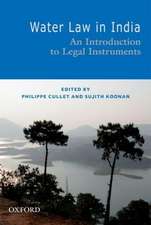Environmental Change in Lesotho: An Analysis of the Causes and Consequences of Land-Use Change in the Lowland Region
Autor Pendo Maroen Limba Engleză Hardback – 20 aug 2011
| Toate formatele și edițiile | Preț | Express |
|---|---|---|
| Paperback (1) | 635.80 lei 6-8 săpt. | |
| SPRINGER NETHERLANDS – 16 oct 2014 | 635.80 lei 6-8 săpt. | |
| Hardback (1) | 642.03 lei 6-8 săpt. | |
| SPRINGER NETHERLANDS – 20 aug 2011 | 642.03 lei 6-8 săpt. |
Preț: 642.03 lei
Preț vechi: 755.33 lei
-15% Nou
Puncte Express: 963
Preț estimativ în valută:
122.86€ • 127.50$ • 102.70£
122.86€ • 127.50$ • 102.70£
Carte tipărită la comandă
Livrare economică 17-31 martie
Preluare comenzi: 021 569.72.76
Specificații
ISBN-13: 9789400718807
ISBN-10: 9400718802
Pagini: 205
Ilustrații: X, 192 p.
Dimensiuni: 155 x 235 x 18 mm
Greutate: 0.46 kg
Ediția:2011
Editura: SPRINGER NETHERLANDS
Colecția Springer
Locul publicării:Dordrecht, Netherlands
ISBN-10: 9400718802
Pagini: 205
Ilustrații: X, 192 p.
Dimensiuni: 155 x 235 x 18 mm
Greutate: 0.46 kg
Ediția:2011
Editura: SPRINGER NETHERLANDS
Colecția Springer
Locul publicării:Dordrecht, Netherlands
Public țintă
GraduateCuprins
Introduction.- The Wealth of Knowledge: Drivers and Consequences of Land-Use Change.- Lesotho: Macro to Micro Perspectives of Land-Use Change.- Village Perceptions of Land-Use Change.-Village Patterns of Land-Use Change.- Discussing Causes and Consequences of Land-Use Change in the Lowland Region.- Conclusions: So What?.- Index.
Textul de pe ultima copertă
The aim of this book is to identify and analyze the drivers of land-use change and the consequences of these changes on the livelihoods of rural land-users/managers. To accomplish this, a combination of tools from the social sciences and environmental fields were developed to identify causes and consequences of land-use change at selected levels, using a ‘nested’ approach. These methods were then applied to a case study of villages in Maseru and Mohale’s Hoek districts in the Lowland region of Lesotho.
Based on the research findings, key proximate drivers of land-use change in the Lowland villages were established. These were drought, lack of water, land mismanagement, HIV/AIDS and ‘dependency syndrome’. These were acted on by underlying and other drivers to bring about major changes in land-use. The book offers an understanding of the actions of local land-users and managers, and their responses to biophysical, social-political, environmental, HIV/AIDS and other stresses, giving an insight into a household’s decision-making behaviour, degree of vulnerability and hence their resilience and adaptive capabilities and mechanisms.
This book is directed at the wide scientific and non-scientific audience including environmental and social science experts, researchers, decision-makers, and development/aid workers interested in understanding the intricate human-environment relationship as it relates to land-use change in a changing biophysical, socio-economic, political and institutional context, coupled by HIV/AIDS, changing demographics, local perceptions and what is termed here ‘dependency syndrome’.
Based on the research findings, key proximate drivers of land-use change in the Lowland villages were established. These were drought, lack of water, land mismanagement, HIV/AIDS and ‘dependency syndrome’. These were acted on by underlying and other drivers to bring about major changes in land-use. The book offers an understanding of the actions of local land-users and managers, and their responses to biophysical, social-political, environmental, HIV/AIDS and other stresses, giving an insight into a household’s decision-making behaviour, degree of vulnerability and hence their resilience and adaptive capabilities and mechanisms.
This book is directed at the wide scientific and non-scientific audience including environmental and social science experts, researchers, decision-makers, and development/aid workers interested in understanding the intricate human-environment relationship as it relates to land-use change in a changing biophysical, socio-economic, political and institutional context, coupled by HIV/AIDS, changing demographics, local perceptions and what is termed here ‘dependency syndrome’.
Caracteristici
This Lesotho case study discusses HIV/AIDS and ‘dependency syndrome’ in the context of human geography Contributes policy-relevant knowledge for decision-making on sustainable land use Challenges some commonly-held myths about land-use change













